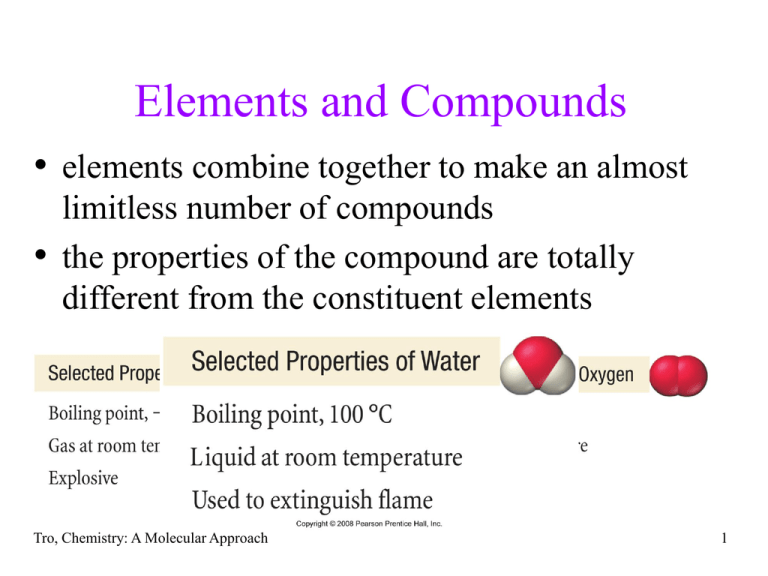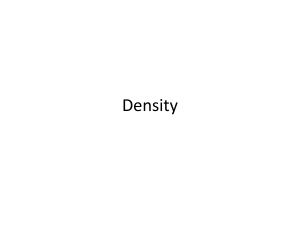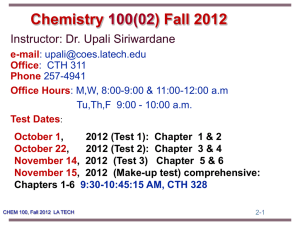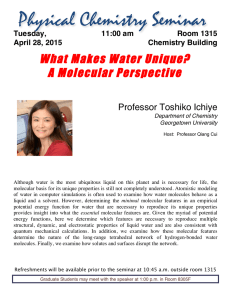Elements and Compounds •
advertisement

Elements and Compounds • elements combine together to make an almost limitless number of compounds • the properties of the compound are totally different from the constituent elements Tro, Chemistry: A Molecular Approach 1 Chemical Bonds • compounds are made of atoms held together by chemical bonds • bonds are forces of attraction between atoms Tro, Chemistry: A Molecular Approach 2 Bond Types • two general types of bonding between atoms found in • compounds, ionic and covalent ionic bonds result when electrons have been transferred between atoms, resulting in oppositely charged ions that attract each other generally found when metal atoms bonded to nonmetal atoms • covalent bonds result when two atoms share some of their electrons generally found when nonmetal atoms bonded together Tro, Chemistry: A Molecular Approach 3 Tro, Chemistry: A Molecular Approach 4 Representing Compounds with Chemical Formula • compounds are generally represented with a chemical formula 5 Types of Formula Empirical Formula • Empirical Formula describe the kinds of elements found in the compound and the ratio of their atoms they do not describe how many atoms, the order of attachment, or the shape the formulas for ionic compounds are empirical Tro, Chemistry: A Molecular Approach 6 Types of Formula Molecular Formula • Molecular Formula describe the kinds of elements found in the compound and the numbers of their atoms they do not describe the order of attachment, or the shape Tro, Chemistry: A Molecular Approach 7 Chemical Formulas Hydrogen Peroxide Molecular Formula = H2O2 Empirical Formula = HO Benzene Molecular Formula = C6H6 Empirical Formula = CH Glucose Molecular Formula = C6H12O6 Empirical Formula = CH2O Tro, Chemistry: A Molecular Approach 8 Types of Formula Tro, Chemistry: A Molecular Approach 9 Molecular View of Elements and Compounds Tro, Chemistry: A Molecular Approach 10 Classifying Materials • atomic elements = elements whose particles are single atoms • molecular elements = elements whose particles are multi-atom molecules • molecular compounds = compounds whose particles are molecules made of only nonmetals • ionic compounds = compounds whose particles are cations and anions Tro, Chemistry: A Molecular Approach 11 Molecular Elements • Certain elements occur as 2 atom molecules Rule of 7’s • Other elements occur as polyatomic molecules P4, S8, Se8 7A H2 N2 7 O2 F2 Cl2 Br2 I2 Tro, Chemistry: A Molecular Approach 12 Molecular Elements Tro, Chemistry: A Molecular Approach 13 Ionic vs. Molecular Compounds Propane – contains individual C3H8 molecules Tro, Chemistry: A Molecular Approach Table salt – contains an array of Na+ ions and Cl- ions 14 Ionic Compounds • metals + nonmetals • no individual molecule units, instead have a 3-dimensional array of cations and anions made of formula units • many contain polyatomic ions several atoms attached together in one ion Tro, Chemistry: A Molecular Approach 15 Writing Formulas for Ionic Compounds 1. 2. 3. 4. 5. Write the symbol for the metal cation and its charge Write the symbol for the nonmetal anion and its charge Charge (without sign) becomes subscript for other ion Reduce subscripts to smallest whole number ratio Check that the sum of the charges of the cation cancels the sum of the anions Tro, Chemistry: A Molecular Approach 16 Write the formula of a compound made from aluminum ions and oxide ions 1. Write the symbol for the metal 2. 3. 4. 5. cation and its charge Write the symbol for the nonmetal anion and its charge Charge (without sign) becomes subscript for other ion Reduce subscripts to smallest whole number ratio Check that the total charge of the cations cancels the total charge of the anions Tro, Chemistry: A Molecular Approach Al+3 column 3A O2- column 6A Al+3 O2Al2 O3 Al = (2)∙(+3) = +6 O = (3)∙(-2) = -6 17 Practice - What are the formulas for compounds made from the following ions? • potassium ion with a nitride ion • calcium ion with a bromide ion • aluminum ion with a sulfide ion Tro, Chemistry: A Molecular Approach 18 Naming Binary Ionic Compounds for Metals with Invariant Charge • Contain Metal Cation + Nonmetal Anion • Metal listed first in formula and name 1. name metal cation first, name nonmetal anion second 2. cation name is the metal name 3. nonmetal anion named by changing the ending on the nonmetal name to -ide Tro, Chemistry: A Molecular Approach 19 Name the following compounds 1. KCl 2. MgBr2 3. Al2S3 Tro, Chemistry: A Molecular Approach 20 Naming Binary Ionic Compounds for Metals with Variable Charge • Contain Metal Cation + Nonmetal Anion • Metal listed first in formula and name 1. name metal cation first, name nonmetal anion 2. second metal cation name is the metal name followed by a Roman numeral in parentheses to indicate its charge determine charge from anion charge common ions Table 3.4 3. nonmetal anion named by changing the ending on the nonmetal name to -ide Tro, Chemistry: A Molecular Approach 21 Name the following compounds 1. TiCl4 2. PbBr2 3. Fe2S3 Tro, Chemistry: A Molecular Approach 22 Example – Writing Formula for Binary Ionic Compounds Containing Variable Charge Metal manganese(IV) sulfide 1. Write the symbol for the cation 2. 3. 4. 5. and its charge Write the symbol for the anion and its charge Charge (without sign) becomes subscript for other ion Reduce subscripts to smallest whole number ratio Check that the total charge of the cations cancels the total charge of the anions Tro, Chemistry: A Molecular Approach Mn+4 S2Mn+4 S2- Mn2S4 MnS2 Mn = (1)∙(+4) = +4 S = (2)∙(-2) = -4 23 Practice - What are the formulas for compounds made from the following ions? 1. copper(II) ion with a nitride ion 2. iron(III) ion with a bromide ion Tro, Chemistry: A Molecular Approach 24 Compounds Containing Polyatomic Ions • Polyatomic ions are single ions that contain more than one atom • Often identified by (ion) in formula • Name and charge of polyatomic ion do not change • Name any ionic compound by naming cation first and then anion Tro, Chemistry: A Molecular Approach 25 Some Common Polyatomic Ions Name Formula Name Formula acetate carbonate hydrogen carbonate (aka bicarbonate) hydroxide nitrate nitrite chromate dichromate ammonium C2H3O2– CO32– hypochlorite chlorite chlorate perchlorate sulfate sulfite hydrogen sulfate (aka bisulfate) hydrogen sulfite (aka bisulfite) ClO– ClO2– ClO3– ClO4– SO42– SO32– HCO3– OH– NO3– NO2– CrO42– Cr2O72– NH4+ Tro, Chemistry: A Molecular Approach HSO4– HSO3– 26 Example – Naming Ionic Compounds Containing a Polyatomic Ion 1. Identify the ions Na2SO4 Na = Na+ because in Group 1A SO4 = SO42- a polyatomic ion 2. Name the cation Na+ = sodium, metal with invariant charge 3. Name the anion SO42- = sulfate 4. Write the name of the cation followed by the name of the anion sodium sulfate Tro, Chemistry: A Molecular Approach 27 Name the following 1. NH4Cl 2. Ca(C2H3O2)2 3. Cu(NO3)2 Tro, Chemistry: A Molecular Approach 28 Practice - What are the formulas for compounds made from the following ions? 1. aluminum ion with a sulfate ion 2. chromium(II) with hydrogen carbonate Tro, Chemistry: A Molecular Approach 29 Hydrates • hydrates are ionic compounds containing a • • specific number of waters for each formula unit water of hydration often “driven off” by heating in formula, attached waters follow ∙ CoCl2∙6H2O • in name attached waters indicated by suffix -hydrate after name of ionic compound CoCl2∙6H2O = cobalt(II) chloride hexahydrate CaSO4∙½H2O = calcium sulfate hemihydrate Hydrate CoCl2∙6H2O Tro, Chemistry: A Molecular Approach Anhydrous CoCl2 Prefix No. of Waters hemi ½ mono 1 di 2 tri 3 tetra 4 penta 5 hexa 6 hepta 7 octa 8 30 Practice 1. What is the formula of magnesium sulfate heptahydrate? 2. What is the name of NiCl2•6H2O? Tro, Chemistry: A Molecular Approach 31 Writing Names of Binary Molecular Compounds of 2 Nonmetals 1. Write name of first element in formula element furthest left and down on the Periodic Table use the full name of the element 2. Writes name the second element in the formula with an -ide suffix as if it were an anion, however, remember these compounds do not contain ions! 3. Use a prefix in front of each name to indicate the number of atoms a) Never use the prefix mono- on the first element Tro, Chemistry: A Molecular Approach 32 Subscript - Prefixes • 1 = mono not used on first nonmetal • • • • 2 = di3 = tri4 = tetra5 = penta- • • • • • 6 = hexa7 = hepta8 = octa9 = nona10 = deca- • drop last “a” if name begins with vowel Tro, Chemistry: A Molecular Approach 33 Example – Naming Binary Molecular BF3 1. Name the first element 2. 3. 4. boron Name the second element with an –ide fluorine fluoride Add a prefix to each name to indicate the subscript monoboron, trifluoride Write the first element with prefix, then the second element with prefix Drop prefix mono from first element boron trifluoride Tro, Chemistry: A Molecular Approach 34 Name the following 1. NO2 2. PCl5 3. I2F7 Tro, Chemistry: A Molecular Approach 35 Write formulas for the following 1. dinitrogen tetroxide 2. sulfur hexafluoride 3. diarsenic trisulfide Tro, Chemistry: A Molecular Approach 36




